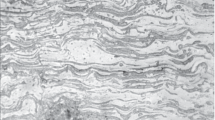Abstract
Plasma spraying is a commonly used technique to apply thin calcium phosphate ceramic coatings. Special consideration is given to retaining the original structure of CPC particles. However, changes are possible. Thus this study focused on plasma spraying induced changes in material characteristics of commercial coatings and their influence onin vitro dissolution. All analysed coatings were found to undergo significant plasma spraying induced changes in phase composition, crystal structure, and specific surface area. The phase transformations depended on the starting particle characteristics. Specifically, β-TCP transformed to α-TCP. HA was dehydroxylated and transformed to oxyhydroxyapatite (OHA), and partly decomposed to α-TCP and tetra calcium phosphate. These transformations lead to a considerable increase ofin vitro dissolution rates at physiological pH.
Similar content being viewed by others
References
P. DUCHEYNE, L. L. HENCH, A. KAGAN, M. MARTENS, A. BURSSENS and J. C. MULIER, “The effect of hydroxyapatite impregnation on skeletal bonding of porous coated implants”,J. Biomed. Mater. Res. 14 (1980) 225–237.
M. JARCHO, “Calcium phosphate ceramics as hard tissue prosthetics”,Clin. Ortho. Rel. Res. 157 (1981) 259–277.
P. DUCHEYNE, K. HEALY, “The effect of plasma sprayed calcium phosphate ceramic coatings on the metal ion release from porous titanium and cobalt chromium alloys”,J. Biomed. Mater. Res. 2 (1988) 1137–1163.
W. LACEFIELD, S. METSGER, N. BLUMENTHAL, P. DUCHEYNE, J. DAVIES, J. KAY, J. STEVENSON and R. SALSBURY, “In vitro analysis of coatings”,J. Appl. Biomater. 1 (1990) 84–87.
J. F. OSBORN, “Assessment of the biomechanical quality of the newly formed bone in micro regions following hydroxyapatite ceramic implantation”, in “Bioceramics”, Vol. 1, edited by H. Oonishi, H. Aoki and K. Sawaki (Ishiyaku Euro America, Kyoto, Japan, 1989) p. 388.
H. OONISHI, M. YAMAMOTO, H. ISHIMARU, E. TSUJI, S. KUSHITANI, M. AONO and Y. UKON, “Comparisons of bone ingrowth in porous Ti-6Al-4V beads uncoated and coated with hydroxyapatite”, in “Bioceramics”, Vol. 1, edited by H. Oonishi, H. Aoki and K. Sawaki (Ishiyaku Euro America, Kyoto, Japan, 1989) p. 400.
P. DUCHEYNE, J. CUCKLER, S. RADIN and E. NAZAR, “Plasma sprayed calcium phosphate lining on porous metal coatings for bone ingrowth”, in “Handbook of bioactive ceramics”, edited by T. Yamamuro, L. L. Hench and J. Wilson (CRC Press, Boca Raton, FL), in Press.
P. DUCHEYNE and M. MARTENS, “Orderly oriented wire meshes (OOWM) as porous coatings on orthopaedic implants. I. Morphology, clinical materials”,1 (1986) 59–67.
P. DUCHEYNE, S. RADIN, J. C. HEUGHEBAERT and M. HEUGHEBAERT, “Calcium phosphate ceramic coatings on metallic porous surfaces. The effect of structure and composition on the electrophoretic deposition, vacuum sintering, andin vitro dissolution behavior”,Biomaterials 11 (1990) 244–254.
J. K. HEINOKEN and R. J. LAHTI, “A new and convenient colorimetric determination of inorganic orthophosphate and its application to the assay of inorganic pyrophosphatase”,Anal. Biochem. 113 (1981) 313–317.
J.C. TROMBE and G. MONTEL, “Some features of the incorporation of oxygen in different oxydation states in apatitic lattice”,J. Inorg. Nucl. Chem. 40 (1978) 15–21.
W. VAN RAEMDONCK, P. DUCHEYNE and P. MEESTER, “Auger electron spectroscopic analysis of hydroxyapatite coating on titanium”,J. Amer. Ceramic Soc. 67 (1984) 381–384.
W. R. LACEFIELD, “Hydroxyapatite coatings in bioceramics: materials characteristics versusin vivo behavior”, edited by P. Ducheyne and J. Lemons.Ann. N.Y. Acad. Sci. 523 (1988) 72.
J. C. CHAE, J. P. COLLIER, M. B. MAYOR and V.A. SUPRENANT, “Efficacy of plasma sprayed tricalcium phosphate in enhancing the fixation of smooth titanium intramedullary rods”, in “Bioceramics: material characteristics versusin vivo behavior”, edited by P. Ducheyne and J. Lemons.Ann. N.Y. Acad. Sci. 523 (1988) 81.
D. P. RIVERO, J. FOX, A. K. SKIPOR, R. M. URBAN and J. O. GALANTE, “Calcium phosphate-coated porous titanium implants for enhanced skeletal fixation”,J. Biomed. Mater. Res. 22 (1988) 191–201.
W. VAN RAEMDONCK, P. DUCHEYNE and P. DE MEESTER, “Calcium phosphate ceramics”, in “Metal and ceramic biomaterials”, Vol. 2, edited by P. Ducheyne and W. Hasting (CRC Press, Boca Raton, FL, 1984) ch. 6, p. 149.
J. C. HEUGHEBAERT, and G. BONEL, “Composition, structure and properties of calcium phosphates of biological interest”, in “Biological performance of biomaterials”, edited by P. Christel, A. Meunier and A. J. C. Lee (Elsevier, Amsterdam, 1986) p. 9.
R. G. T. GEESINK, K. De GROOT and C. KLEIN, “Chemical implant fixation using hydroxyapatite coatings”,Clin. Orthop. Rel. Res. 225 (1987) 147.
S. COOK, K. THOMAS, J. KAY and M. JARCO, “Hydroxyapatite coated titanium for orthopaedic applications”,Clin. Orthop. Rel. Res. 232 (1988) 225.
J. F. OSBORN, “Bonding osteogenesis under loaded conditions — the histological evaluation of a human autopsy specimen of a hydroxyapatite ceramic coated stem of a titanium hip prosthesis”, in “Bioceramics”, edited by H. Oonishi, H. Aoki and K. Sawai (Kyoto, Japan, 1989) p. 388.
K. De GROOT, “Effect of porosity and physicochemical properties on the stability, resorption and strength of calciumphosphate ceramics”, in “Bioceramics: materials characteristics versusin vivo behavior”, edited by P. Ducheyne and J. Lemons.Ann. N.Y. Acad. Sci. 523 (1988) 227.
F. C. M. DRIESSENS, “Physiology of hard tissues in comparison with solubility of synthetic calcium phosphates”, in “Biocheramics: materials characteristics versusin vivo behavior”, edited by P. Ducheyne and J. Lemons.Ann. N.Y. Acad. Sci. 523 (1988) 131.
C. K. HANES, J. P. COLLIER and M. B. MAYOR, “The use of tricalcium phosphate to provide enhanced early fixation of porous coated implants”, in Trans. 11th. Ann. Soc. Biomat. Mtg, 1985, p. 176.
D. A. TESKE, M. B. MAYOR, J. P. COLLIER and V. A. SURPRENANT, “A comparative study of the effectiveness of plasma sprayed hydroxyapatite and tricalcium phosphate coatings in enhancing the fixation of smooth Ti-6Al-4V implants”, in Trans. 35th Ann. Mtg, ORS, 1989, p. 333.
Author information
Authors and Affiliations
Rights and permissions
About this article
Cite this article
Radin, S.R., Ducheyne, P. Plasma spraying induced changes of calcium phosphate ceramic characteristics and the effect onin vitro stability. J Mater Sci: Mater Med 3, 33–42 (1992). https://doi.org/10.1007/BF00702942
Received:
Accepted:
Issue Date:
DOI: https://doi.org/10.1007/BF00702942




